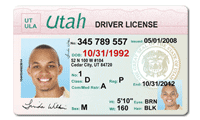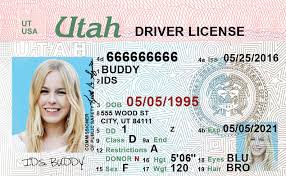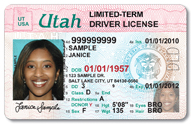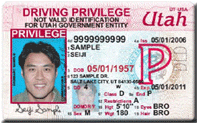CLASS ONE
INTRODUCTION TO DRIVING
DRIVER EDUCATION1. Driver education is mandatory for new drivers ages 15 to 18.
2. 15 years old are eligible to apply for Utah learner permit, fee is $19.00
3. 15 years old are eligible to complete driver education course, our cost is $280.00
4. 15 years old will be licensed when the turn 16 or have held their permit for 6 months.
5. License fee for those under 21 is $39.00
6. License fee for those 21+ is $52.00
LEARNER PERMIT HOLDING PERIODS
Age 15, 16, and 17 - 6 months
Age 18 - must obtain learner permit, but no holding period, must complete an approved driver education course, our cost is $280.00
Age 19 or older - 3 months - the 3 months will be waived if the applicant complete an approved driver education course, our cost is $280.00
The written knowledge test scores for a learner permit are valid for 12 months. If you renew your permit or let it expire more than six months you will be required to retake the written knowledge test.
HOW MANY TESTS MUST I TAKE BEFORE I GET MY LICENSE?
1. Learner permit written exam - 50 questions at Driver License Division to obtain your permit
2. 50 question written final exam in our office if you enrolled in our Home study course.
3. All new drivers in Utah must take Utah Highway Safety and Trends Exam online before you obtain your license -
https://secure.utah.gov/dlexams/ 4. Driving Skill Test otherwise known as "Road Test" with another driving school or with Driver license division. Remember you can not take the final road test with the same driving school where you completed your driver's education. Click here to see list of Third Party Road Tester or Drive Right 801-943-2200 our first recommendation.
https://dld.utah.gov/license-permit-idcard/driver-education/ Driver License Offices within the Valley
West Valley
2780 West 4700 S,
West Valley City, UT 84129
Call Center: 801-965-4437
Hours: Monday - Friday 7:00 am - 6:00 pm
Fair Park, Salt Lake City
1095 Motor Ave,
Salt Lake City, UT 84116
Call Center: 801-965-4437
Hours: Monday - Friday: 8:00 am - 5:00 pmDraper
14555 South Minuteman Drive
Draper, UT 84020
Call Center: 801-965-4437
Hours: Monday - Friday: 7:00 am - 6:00 pm
1. WHY DRIVER EDUCATION?
Duration: 8:03 minutes
2. READY TO DRIVE
Before you get in your car, you need to check around the car to make sure there is nothing around, under and behind the car that may pose as a hazard.
Duration: 1:22 minutes
2. ADJUSTING YOUR SITTING AND MIRRORS
In this section you will learn how to adjust your seat, mirrors, safety belt for comfortable and safe driving.
Duration: 10:09 minutes
Adjusting Your Sitting and Mirrors
3. GETTING STARTEDIn this section you will learn how to start a car, engage the gear, put the car in motion, braking, hand position, backing, signalling and speed.
Duration: 3:26 minutes
Getting Started
Before you start driving, you need to know how to drive defensively, how to protect yourself against aggressive drivers and road rangers. It is important also to learn how to properly interact with highway patrol and police officers. In this section we will go over these aspects of driving.
5. DEFENSIVE DRIVING
Always be prepared to react to the other driver driving errors. Do not expect the other driver to do what you think he/she should do. Do not think you know what he/she is going to do. If you cannot avoid a crash, remain calm and try to choose the least dangerous situation.
Duration: 1:54 minutes
Defensive Driving
6. AGGRESSIVE DRIVING
Aggressive driving is the operation of a motor vehicle in a manner that endangers or is likely to endanger persons or property. Persons doing any of the following may be committing acts of aggressive driving.
- Speeding
- Running red lights and stop signs
- Tailgating
- Passing on the shoulder of the road
- Cutting off another vehicle
- Slamming on brakes in front of a tailgater
- Improper hand or facial gestures at other drivers
- Yelling
- Repeatedly honking the horn
- Repeatedly flashing headlights
Aggressive driving is a serious problem that is responsible for many traffic crashes and fatalities. It is to your benefit to avoid aggressive drivers and potentially dangerous situations. If you encounter an angry or aggressive motorist:
- Do not retaliate or in any way engage the other driver. Get out of the way.
- Do not make eye contact.
- Keep your doors locked and your windows up.
- Keep enough space between you and the vehicle in front of you to pull out from behind.
- Do not underestimate the other driver’s potential for aggression.
Anyone can become an aggressive driver. Do not let stress and frustration get the best of you while driving.
- Be patient and courteous.
- Do not drive when angry, overtired or upset.
- Allow extra time to get to your destination.
- When possible, change your schedule to avoid congestion.
- Listen to relaxing music or books on tape.
- Give other drivers the benefit of the doubt - all drivers make mistakes.
- Avoid all conflict, even if you are right.
7. ROAD RAGE
Duration: 1:46 minutes
The following are common manifestations of road rage:
- Generally aggressive driving, including sudden acceleration, braking, and close tailgating
- Cutting others off in a lane, or deliberately preventing someone from merging.
- Chasing other motorists
- Flashing lights and/or sounding the horn excessively.
- Driving at high speeds in the median of a highway to terrify drivers in both lanes.
- Rude gestures such as giving the finger.
- Shouting verbal abuse or threats.
- Intentionally causing a collision between vehicles.
- Hitting other vehicles.
- Assaulting other motorists, their passengers, cyclists or pedestrians.
- Exiting the car to attempt to start confrontations, including striking other vehicles with an object.
- Threatening to use or using a firearm or other deadly weapon.
- Throwing object from a moving vehicle with the intent of damaging other vehicles.
Being Pulled Over by Law Enforcement
Duration: 1:35 minutes
- Slow down and pull over safely as soon as possible.
- Stay in the driver’s seat with both hands clearly in sight on the steering wheel until the officer instructs you otherwise or the traffic stop is complete. Do not exit your vehicle unless asked to do so. Getting out of your vehicle can be perceived as aggressive behavior and a threat to the officer’s safety. Turn on your interior light if stopped at night.
- Comply with the officer’s request to see your driver’s license and proof of insurance. If these items are in the glove box or under the seat, inform the officer of that fact and then follow his/her directions before retrieving them.
- If you are issued a ticket requiring a signature, sign it. Signing a ticket is not an admission of guilt–only an acknowledgment of receiving the ticket.
- If you are suspected of drunk driving, cooperate with the officer(s) on the scene. If you refuse to submit to breath, blood or performance tests, your refusal could result in loss of driving privileges.
- Get out of the automobile only if asked to do so.
- Be aware that you may have committed some minor traffic violation without realizing it, there may be some problem with your vehicle of which you are unaware, or you might be driving a vehicle that is similar to one used in a serious crime. Many officers will not provide specific reasons for the stop until they have your license and insurance card in hand. Therefore, they will avoid having to debate the reason for the stop before they receive these items from you.
- If you wish to offer an explanation of your circumstances when stopped, do so before the officer returns to his vehicle. The officer cannot void the ticket once it has been written. Cooperate during the incident even if you believe you haven’t committed an offense. If you believe you have been treated unfairly, present your case in traffic court and not to the officer along the roadway.
- You are to be treated with dignity and respect by the officer. If you believe that an officer has acted inappropriately during a traffic stop or other encounter, you should report that conduct as soon as possible to the officer’s superiors.
- Officers are required to provide their names and badge number upon request.
- Be polite and cooperate with any law enforcement officer when pulled over for routine traffic check.
LICENSE TYPES
The statistic below is for the assignment in your workbook
THE TOP FIVE LEADING CAUSES OF DEATH ON UTAH ROADS
Speed too fast 37% Unrestrained Occupants 31% Drunk Driving 13% Failed to Yield Right of Way 11% Failed to Keep in Proper ane 11%
THE TOP FIVE LEADING CAUSES OF CRASHES ON UTAH HIGHWAYS
Following too closely 22% Failed to Yield Right of Way 18% Speed Too Fast 18% Failed to Keep in Proper Lane 12% Distracted Driving 10%
THE TOP FIVE LEADING CAUSES OF DEATH ON UTAH HIGHWAYS (TEENAGERS)
Speed Too Fast 33% Failed to Keep in Proper Lane 23% Disregard Traffic Signal/Sign 17% Overcorrected 17% Failed to Yield, Driver Distraction 13%
THE TOP FIVE LEADING CAUSE OF CRASHES ON UTAH HIGHWAYS (TEENAGERS)
Following too Closely 21% Failed to yield right-of-way 18% Speed too fast 12% Driver distraction 9% Failed to keep in proper lane 8%
DRIVING BY MINORS - TEENAGE DRIVER RESTRICTIONS
Accompanied by a licensed driver 21 years of age in the front seat.
On agricultural assignment
Driving to and from work
Driving to and from a school sponsored activity.
Emergency situations
Accompany by a licensed driver 21 years of age in the front seat.
On agricultural assisgnment
Emergency situations
Getting to Know Your Car
Duration: 13:17 minutes
Click on the link below to take end of class test
ANNOUNCEMENT!
Our test results server is down. In the meantime, do not use the SUBMIT button, just write down your test scores and
email it to me @ ndstestresults@yahoo.com



